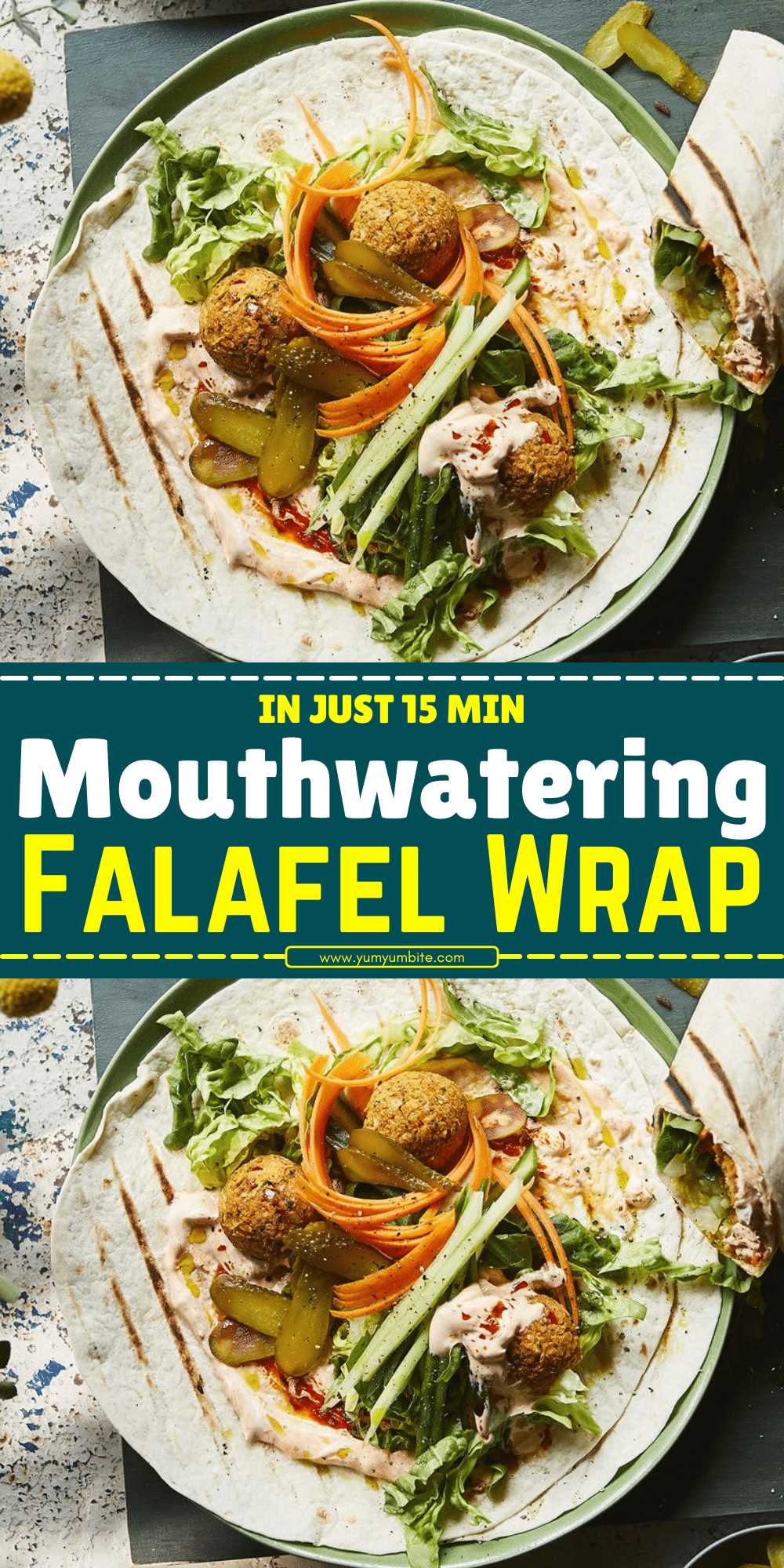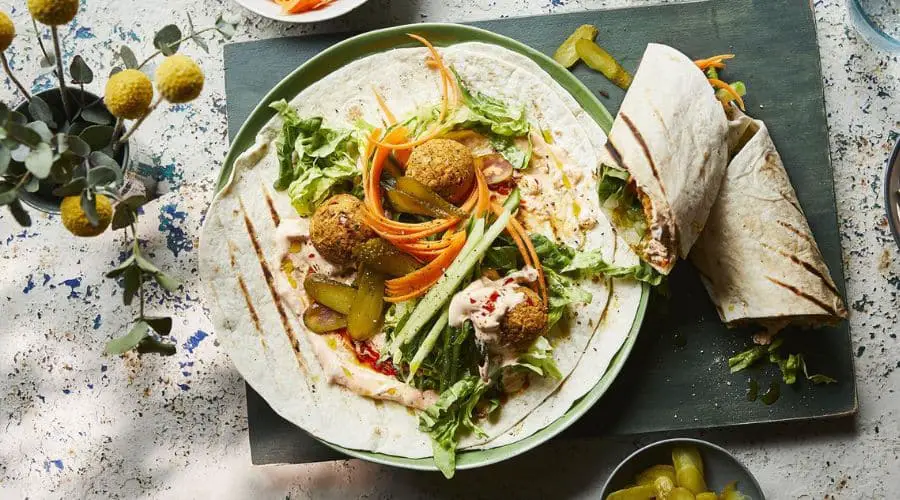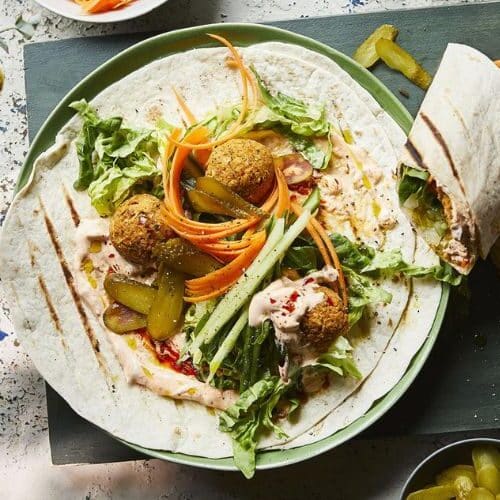Falafel wraps are a popular and satisfying meal that brings together crispy falafel, fresh vegetables, and savory sauces all wrapped in a soft pita or flatbread.
Originating from the Middle East, falafel has become a beloved dish worldwide, offering a perfect balance of textures and flavors.
The golden, crunchy exterior of falafel contrasts beautifully with its soft, flavorful interior made from chickpeas, herbs, and spices.
When wrapped up with crunchy vegetables and creamy sauces, it creates a meal that is both refreshing and filling.
Falafel wraps are not only delicious but also versatile, making them a great choice for vegans, vegetarians, or anyone looking to enjoy a healthy, plant-based meal.
You can customize the wrap to suit your tastes, adding different veggies, sauces, or even a bit of spice for an extra kick.
Whether you enjoy it as a quick lunch, a light dinner, or a fun party appetizer, the falafel wrap is sure to satisfy your cravings and leave you feeling nourished.

Ingredients for the Perfect Falafel Wrap
To make a falafel wrap that is bursting with flavor, you’ll need a few essential ingredients for both the falafel and the wrap. Here’s what you’ll need:
For the Falafel:
- Chickpeas – The base of the falafel, providing a hearty texture and earthy flavor. You can either soak dried chickpeas overnight or use canned chickpeas for convenience.
- Fresh herbs – Parsley and cilantro are the classic herbs used in falafel, giving it a refreshing and aromatic quality.
- Spices – Ground cumin, coriander, garlic, and a pinch of cayenne pepper for that authentic Middle Eastern flavor.
- Baking soda – To help the falafel puff up and become light and airy on the inside.
- Onions – Adding a touch of sweetness and depth of flavor.
- Flour – For binding the mixture together; chickpea flour is a great gluten-free option.
- Salt and pepper – To season the falafel to your liking.
For the Wrap:
- Pita bread or flatbread – Soft and warm, this is the ideal base for your falafel, able to hold everything together while still being soft enough to fold.
- Fresh vegetables – Lettuce, tomatoes, cucumbers, and red onions provide a refreshing crunch and balance the richness of the falafel.
- Pickles – Optional, but adding a bit of tanginess to the wrap can enhance the flavor and add an extra layer of taste.
- Sauces – Choose from tahini, hummus, yogurt-based sauce, or a spicy harissa sauce to complement the falafel. These sauces add a creamy and flavorful touch that ties the whole wrap together.
How to Make Homemade Falafel for the Wrap

Making falafel from scratch is easier than you might think, and the results are incredibly satisfying. The key to achieving perfectly crispy falafel is in the preparation and balance of ingredients. Follow these steps to create your own homemade falafel:
Step 1: Prepare the Chickpeas
Start by soaking dried chickpeas in water overnight. This step is crucial, as it softens the chickpeas and helps them blend smoothly. If you’re short on time, you can use canned chickpeas, but make sure to drain and dry them well to avoid a soggy mixture.
Step 2: Blend the Ingredients
In a food processor, add the soaked chickpeas along with the fresh herbs, garlic, onion, and spices. Pulse until the mixture is finely chopped, but not pureed. You want a coarse texture that will hold together when shaped into balls. Add flour (or chickpea flour for a gluten-free option) to help bind everything together, along with baking soda to give the falafel a light, airy texture. Season the mixture with salt and pepper to taste.
Step 3: Shape the Falafel
Using your hands, take small portions of the falafel mixture and roll them into balls or patties. Make sure they’re compact but not too tight, so they don’t fall apart during cooking. You can refrigerate the falafel balls for about 30 minutes to help them firm up, which also improves their texture.
Step 4: Cook the Falafel
The traditional way to cook falafel is by deep-frying it in hot oil until golden and crispy on the outside. However, for a lighter option, you can also bake the falafel at 375°F (190°C) for about 25 minutes, flipping halfway through.
Frying gives the falafel that signature crispy texture, but baking works just as well if you’re looking for a healthier alternative.
Once cooked, the falafel should have a beautiful golden crust with a soft, flavorful interior. Now, it’s ready to be placed in your wrap!
Assembling the Perfect Falafel Wrap
Assembling a falafel wrap is a fun and customizable process that allows you to add your favorite fresh ingredients and sauces. Follow these simple steps to create the perfect wrap:
Step 1: Choose Your Wrap Base
Start by selecting your preferred wrap base. Pita bread is the most common option, offering a soft and slightly chewy texture that perfectly holds the falafel and other fillings.
If you’re looking for a lighter or gluten-free option, you can choose a gluten-free wrap or a large lettuce leaf as your base. Warm the bread slightly to make it more pliable and easier to fold.
Step 2: Layer Fresh Vegetables
Next, add a layer of fresh vegetables to your wrap for a refreshing crunch. Start with a handful of leafy lettuce for a crisp base. Add thin slices of cucumber, tomatoes, and red onions for a burst of color and flavor.
If you prefer extra crunch, consider adding shredded carrots or cabbage. Pickled vegetables, like pickled cucumbers or turnips, add a tangy bite that complements the richness of the falafel.
Step 3: Add the Falafel
Place the crispy falafel balls or patties on top of your vegetable layer. The falafel should be slightly warm, allowing it to stay crispy while still being tender and flavorful on the inside. You can fit two to four falafel balls into the wrap, depending on the size of your bread and your personal preference.
Step 4: Drizzle with Sauce
One of the highlights of a falafel wrap is the sauce. Drizzle your chosen sauce generously over the falafel. A classic tahini sauce, with its creamy and nutty flavor, works beautifully with falafel. Alternatively, you could use a tangy yogurt-based sauce, a spicy harissa, or a smooth hummus for added richness. Experiment with flavors to find your favorite combination!
Step 5: Wrap It Up
Carefully fold in the sides of the pita or flatbread and roll it tightly to enclose all the ingredients. Make sure the wrap is secure and easy to hold. For extra security, you can wrap the bottom of the wrap with parchment paper or foil, making it easier to enjoy without spills.
Your falafel wrap is now ready to be enjoyed—packed with layers of flavor, texture, and nutrients!
Nutritional Benefits of a Falafel Wrap
Falafel wraps are not only delicious but also offer several health benefits, making them a well-rounded meal choice for those looking to eat healthily. Here’s a breakdown of the key nutritional benefits of a falafel wrap:
Rich in Plant-Based Protein
The chickpeas used to make falafel are an excellent source of plant-based protein, making this wrap a satisfying and protein-rich meal. Protein is essential for muscle repair, immune function, and maintaining energy levels throughout the day. For those following a vegetarian or vegan diet, falafel is a great way to incorporate high-quality protein into your meals.
High in Fiber
Chickpeas, along with the vegetables added to the wrap, are high in dietary fiber. Fiber plays a crucial role in digestive health by promoting regular bowel movements, preventing constipation, and supporting a healthy gut microbiome. It also helps with weight management by keeping you full for longer periods, preventing overeating.
Packed with Fresh Vegetables
Falafel wraps are typically filled with a variety of fresh vegetables, such as lettuce, cucumbers, tomatoes, and onions. These vegetables are rich in vitamins, minerals, and antioxidants, which help support overall health.
For example, cucumbers provide hydration, tomatoes are an excellent source of vitamin C and lycopene, and lettuce offers folate and fiber. Adding pickled vegetables can also provide probiotics, contributing to gut health.
Healthy Fats from Sauces
When you add a sauce like tahini (made from sesame seeds) or a yogurt-based dressing, you’re incorporating healthy fats into the wrap. These fats are essential for brain function, hormone regulation, and absorption of fat-soluble vitamins like vitamins A, D, E, and K. Tahini, in particular, also provides a good source of calcium, making it beneficial for bone health.
Customizable for Different Dietary Needs
One of the greatest benefits of the falafel wrap is its versatility. You can easily adapt the recipe to suit various dietary needs. For a gluten-free version, simply swap out the pita for a gluten-free wrap or lettuce leaves. You can also opt for baked falafel instead of fried falafel to reduce the overall fat content while still enjoying that crispy texture.
Low in Saturated Fat
When made with healthy oils for frying or baked instead of fried, falafel wraps are a low-saturated fat option, helping to maintain healthy cholesterol levels. Using fresh, wholesome ingredients ensures the wrap remains light while still providing ample flavor and texture.
Tips for Meal Prep and Storage
Falafel wraps are perfect for meal prep, allowing you to enjoy a delicious and healthy meal even on busy days. Here are some tips to help you prepare and store your falafel wrap components in advance:
1. Prepare Falafel in Advance
You can make falafel ahead of time and store it for later use. After cooking, allow the falafel to cool completely, then store it in an airtight container in the refrigerator for up to 3 days. For longer storage, freeze the cooked falafel in a single layer, then transfer to a freezer bag.
Frozen falafel can last up to 3 months. When ready to eat, reheat in the oven for a few minutes to restore its crispy texture.
2. Store Wrap Components Separately
To keep everything fresh and prevent sogginess, store the individual components separately. Keep the pita or flatbread in a resealable bag at room temperature for up to 2 days or freeze for longer storage.
Fresh vegetables like lettuce, tomatoes, cucumbers, and onions should be chopped and stored in airtight containers in the refrigerator, but avoid adding the tomatoes until right before serving to prevent excess moisture.
3. Make Your Sauces Ahead of Time
Sauces like tahini, hummus, or yogurt-based dressings can be made in advance and stored in the fridge for up to a week. Store the sauces in separate containers so you can easily drizzle them on the falafel when assembling your wrap.
4. Assemble the Wrap Fresh
While you can prep all the ingredients, it’s best to assemble the falafel wrap just before eating to keep it fresh and flavorful. If you’re taking the wrap on the go, wrap it tightly in foil or parchment paper to prevent it from falling apart and keep everything intact.
5. Reheat Falafel Properly
If you have leftover falafel, reheat it in the oven rather than the microwave to retain its crispy texture. Preheat the oven to 375°F (190°C) and bake for 5-10 minutes until warm and crispy again.
Conclusion
Falafel wraps are a delicious and healthy meal that brings together the crispy goodness of homemade falafel, fresh vegetables, and a variety of flavorful sauces.
Whether you’re preparing a quick lunch, enjoying it for dinner, or serving it as an appetizer for a gathering, falafel wraps are versatile, satisfying, and easy to customize.
They’re packed with plant-based protein, fiber, and essential nutrients, making them a perfect choice for a balanced and nutritious meal.
By prepping the components in advance and storing them separately, you can make falafel wraps whenever you need them without compromising on freshness or flavor.
With endless variations and endless possibilities for customization, falafel wraps will become a staple in your meal rotation.
So gather your ingredients, roll up your wrap, and enjoy a wholesome, mouthwatering meal today!
Frequently Asked Questions
1. Can I make falafel wraps gluten-free?
Yes! To make a gluten-free falafel wrap, simply swap the pita bread with a gluten-free wrap or use a lettuce leaf as the base. You can also use gluten-free flour when making the falafel. Just be sure to check the ingredients in the sauces as well, as some may contain gluten.
2. How do I store leftover falafel?
After cooking, allow the falafel to cool completely, then store it in an airtight container in the refrigerator for up to 3 days. You can also freeze the cooked falafel for up to 3 months. To reheat, bake in the oven to restore its crispy texture.
3. Can I bake falafel instead of frying it?
Yes, you can bake falafel for a healthier option. Preheat the oven to 375°F (190°C) and bake the falafel for about 25 minutes, flipping halfway through, until golden and crispy on the outside.
4. How do I prevent my falafel from falling apart?
To ensure your falafel stays intact during cooking, make sure the mixture is not too wet. If necessary, add extra flour to help bind it. Also, refrigerating the falafel before cooking can help it firm up and reduce the risk of it falling apart.
5. Can I use canned chickpeas for falafel?
Yes, canned chickpeas are a convenient option for making falafel. Just be sure to drain and thoroughly dry them to remove excess moisture, which can make the falafel mixture too wet and difficult to shape.

Falafel Wrap
Equipment
- 1 Large mixing bowl (for falafel mixture)
- 1 Food processor (for mixing falafel ingredients)
- 1 Skillet or frying pan (for frying falafel)
- 1 Baking sheet (for baking falafel)
- 1 Parchment paper or foil (for wrapping falafel wrap)
- 1 Knife for chopping vegetables
- 1 Cutting board (for chopping vegetables)
- 1 Small bowl (for sauces)
Ingredients
For the Falafel:
- 1 ½ cups 240g cooked chickpeas (or 1 can)
- 1 small onion finely chopped (½ cup)
- 2 cloves garlic minced
- 1 cup 30g fresh parsley, chopped
- 1 cup 30g fresh cilantro, chopped
- 2 tablespoons flour or chickpea flour for gluten-free option
- 2 teaspoons ground cumin
- 1 teaspoon ground coriander
- 1 teaspoon ground paprika
- ½ teaspoon cayenne pepper optional, for heat
- Salt and pepper to taste
- 2 tablespoons olive oil for frying or baking
- 1 teaspoon baking powder
For the Wrap:
- 4 pita breads or gluten-free wraps
- 1 cup 50g lettuce, shredded
- 1 cucumber sliced
- 1 tomato sliced
- ½ small red onion thinly sliced
- ½ cup 80g pickled vegetables (optional)
- ½ cup tahini sauce or yogurt-based sauce optional
Instructions
Prepare the Falafel Mixture:
- In a food processor, combine the chickpeas, onion, garlic, parsley, cilantro, cumin, coriander, paprika, cayenne, salt, and pepper. Pulse until the mixture is coarse but holds together when pressed.
- Add flour and baking powder, then pulse again until fully incorporated. If the mixture feels too wet, add a bit more flour until it holds its shape.
Shape the Falafel:
- With wet hands, shape the falafel mixture into small balls or patties (about 2-3 inches in diameter).
Cook the Falafel:
- For frying: Heat olive oil in a skillet over medium heat. Fry the falafel for 2-3 minutes on each side or until golden brown and crispy.
- For baking: Preheat the oven to 375°F (190°C). Place falafel on a baking sheet lined with parchment paper and bake for 25 minutes, flipping halfway through.
Prepare the Wrap:
- While the falafel is cooking, prepare the vegetables. Slice the cucumber, tomato, and onion, and shred the lettuce.
Assemble the Wrap:
- Lay a pita or gluten-free wrap flat on a surface. Add a layer of shredded lettuce, followed by cucumber, tomato, and onion slices.
- Place 2-3 falafel balls on top and drizzle with your choice of tahini sauce, yogurt sauce, or any other preferred dressing.
- Add any optional pickled vegetables and fold the wrap tightly.
Serve:
- Serve immediately and enjoy your flavorful and nutritious falafel wrap!
Notes
- Gluten-Free Option: Use gluten-free wraps or lettuce leaves instead of pita.
- Storage: Store leftover falafel separately in the refrigerator for up to 3 days. For longer storage, freeze falafel and reheat in the oven.
- Make-Ahead: Prepare the falafel mixture the night before and refrigerate. Shape and cook the falafel fresh when ready to assemble.
- Alternative Sauces: Experiment with different sauces like hummus, tahini yogurt sauce, or even a spicy harissa for more flavor.
- For a Crispy Exterior: If baking, spray the falafel with a little olive oil before baking to help achieve a crisp exterior.


